|
|
Trees: Pinyon Pine
Single leaf Pinyon Pine - Pinus Monophylla
Regeneration Processes:
-- Fertilization
|
Reproduction in singleleaf pinyon is by seed and does not occur
naturally by vegetative means. It bears both male and female flowers and is wind pollinated.
Cone and seed development require 3 seasons and about 26 months.
The seed bearing cones begin growing the season before the spring they appear and are dormant
through the preceding winter.
|
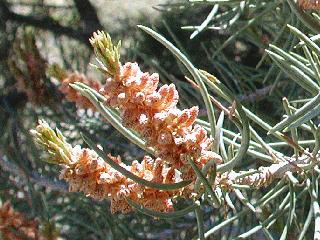
|

|
Pollen release is controlled by local conditions. Once
pollinated, growth of the pollen tube undergoes another winter dormancy period
prior to fertilization. After fertilization, seeds develop rapidly, mature, and
disperse about 6 months later, the 2nd autumn after pollination. With so much
time between so many stages, cone and seed crops are exposed to a number
of variables that affect the seed crop, such as weather, predation, and
internal competition for resources between the previous and current year's
cones; therefore, seed production is highly variable from tree to tree, year to
year, and place to place.
|
Bearing Cones
Singleleaf pinyon generally begins bearing cones at
about 35 years of age, begins producing good seed crops at about 75 to 100
years, and reaches maximum production at about 160 to 200 years.
Singleleaf pinyon exhibits region-wide synchrony in cone production, masting
every 2 to 3 years.
Some seeds may be produced every year,
and good seed crops occur somewhere over a geographical area (e.g. the Great
Basin) nearly every year.
|
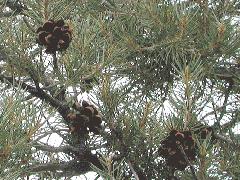
|

|
A 5-year study reported per acre cone production as follows: 1975, 765 cones;
1976, 0 cones; 1977, 2,560 cones; 1978, 2,325 cones; 1979, 585 cones.
Mast years in singleleaf pinyon may be related to the polar front jet stream.
|
|
Singleleaf pinyon is said to be more productive and predictable than Colorado
pinyon, with seed production being predicted fairly accurately 2 years in
advance and more accurately 1 year in advance. Seed
production and survival may be affected by several insect pests of cones and
seeds. For example, the pinyon cone beetle can destroy more than 50% of the crop
of its host pinyon, while coneworms tunnel in cones and shoots but are of minor
importance.
For other pests, such as the pinyon cone borer, the magnitude of the effects is
unknown.
|
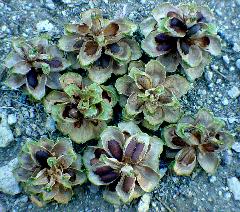
|
Pinyon Seeds
Because singleleaf pinyon seeds are totally wingless,
seed dispersal is dependent on vertebrate dispersers that store seeds in food
caches, where unconsumed seeds germinate. This dispersal mechanism is a good
example of a co-evolved, mutualistic, plant-vertebrate relationship.
The cone scales of singleleaf pinyon have a membranous tissue that holds the
seed in place after the cones open, protecting them from ground-foragers and
keeping them available to avian dispersers.
|
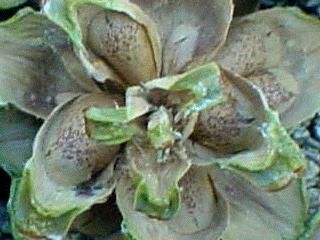
Membranous tissue holding seeds in place
|
Several corvids are responsible for
dispersal of singleleaf pinyon seeds over distance. Scrub and Steller's jays
forage alone or in pairs, carrying 1 to a few seeds less than a mile before
burying them. Pinyon jays forage in flocks of hundreds, carrying about 40 nuts
each up to 5 miles (8.3 km) before caching them in the soil. Clark's nutcrackers
forage in somewhat smaller flocks, each carrying several dozen seeds a distance
of up to 13 miles (22 km) and burying 1 to 15 seeds per cache, 1 to 3 cm deep in
gravelly soil, mineral soil, or duff.
Seed caching by Clark's nutcrackers begins late August to early September.
In a good seed crop year, an individual Clark's nutcracker may scatter-hoard
17,900 singleleaf pinyon seeds.
The large range of singleleaf pinyon may be attributable, in part, to seed
dispersal by these birds. Seed
dispersal by humans in the past has also been suggested.
|
Chipmunks, squirrels, deer mice, pinyon mice, Great Basin pocket mice, and
Panamint kangaroo rats all scatter-hoard singleleaf pinyon seeds locally.
These animals consume most of the seed, but some is left to germinate.
Quantitatively, these rodents are less effective than avian dispersers, since it
is only in mast years that large numbers of seeds fall to the ground and become
available to rodents. The seed characteristics and the microhabitats in which
seeds are placed are important in determining their fate after dispersal.
Rodents are qualitatively effective dispersers of singleleaf pinyon seed since
they tend to bury seeds under and adjacent to shrubs, whereas avian dispersers
tend to cache seeds in interspace environments, a less suitable environment for
singleleaf pinyon seedlings.
|
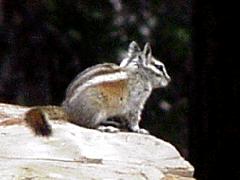
Vertebrate disperser
|
|
In general, pinyon seeds are short-lived with little innate dormancy and
thus form only a temporary seed bank.
Fresh seeds have 85 to 95% viability, but this decreases in a year or less.
Most seeds germinate the spring following dispersal,
requiring 28 to 90 days of cold stratification for germination.
Germination and establishment are most likely when favorable moisture conditions
follow a mast year. Seeds may germinate in the open, but seedling establishment
in the open is rare.
|
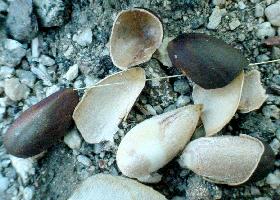
|
Pinyon Seedlings
Singleleaf pinyon seedling establishment is episodic.
Population age structure is affected by drought, which differentially reduces
seedling and sapling recruitment more than other age classes. Top-growth
of seedlings is slow (1.0 inch (2.5 cm) per year in height, and 0.012 inch (0.3
mm) per year in diameter). Root growth is more rapid, with the taproot reaching
6 inches (15 cm) 10 days after germination.
Seedlings can thereby withstand soil water below the wilting point for about 2
weeks. However, field drought conditions are often more severe than this, and so
seedlings only survive in the most favorable microenvironments. Singleleaf
pinyon seedlings survive best in the microhabitat provided by nurse plants,
where organic matter, nutrient concentrations, relative humidity, water
infiltration, and water holding capacity tend to be higher, and irradiance and
soil temperatures tend to be lower.
However, nurse plants also compete for water and nutrients, so the trade-off is
slower seedling growth rate.
Seedlings maintain a more favorable water status and have greater drought
avoidance than shrub nurse plants.
The complex interaction between seedlings and nurse plants is a balance between
facilitation and competition on moisture and light gradients.
|
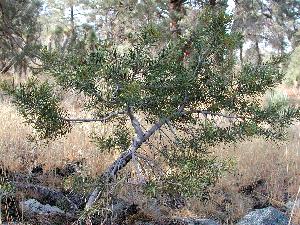
Pinon Seedling
|
Ecotones
The ecotones between singleleaf pinyon woodlands and
adjacent shrublands and grasslands provide favorable microhabitats for
singleleaf pinyon seedling establishment since they are active zones for seed
dispersal, nurse plants are available, and singleleaf pinyon seedlings are only
affected by competition from grass and other herbaceous vegetation for a couple
of years. This facilitates expansion of woodlands along these ecotones, with
singleleaf pinyon seedlings eventually overtopping and shading out the shrubs.
Conversely, singleleaf pinyon seedlings establishing under adult trees have
little chance of maturing unless the adult tree is removed or dies.
|
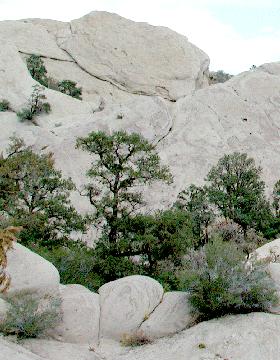
|
Pinyon Growth
Singleleaf pinyon is slow growing. A dominant tree
requires about 60 years to reach 6.6 feet (2 m) in height, and about 150 years
to attain 28 feet (8.5 m) in height and a stump height diameter of about 12
inches (30 cm).
Average annual height and diameter growth of immature dominants is about 2
inches (5 cm), and 0.04 to 0.20 inch (1 to 5 mm), respectively. Growth rates
vary considerably even among trees on identical sites, and are greatly
influenced by competition for severely limited water supplies. Dominant trees
may maintain constant diameter growth rates for more than 200 years. Observed
reductions in growth rates with age are likely caused by increasing competition
as stands develop, and no definite age of culmination of growth has been
determined.
|
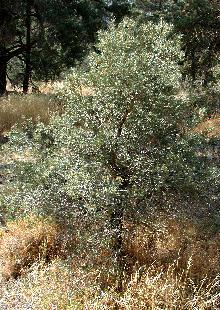
Pinon, 7-8' feet tall
|
Next >
< Previous
|










